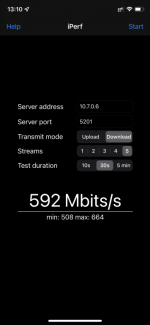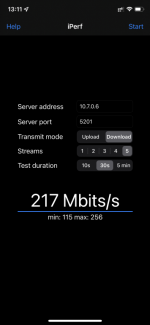I was able to perform additional speed tests on the AX73 router with Intel AX200 and AX210 clients running in AX mode. This time I used two independent server-client pairs working simultaneously (LAN-> WLAN) + (LAN-> WLAN). That is, the Iperf3 servers are connected to the router with a cable. Clients are wireless.
The commands i used are of this kind. For DL (from server to client):
iperf-3.1.3-win64 \ iperf-3.1.3-win64 \ iperf3.exe -c 192.168.1.70 -R -P 8 -t 30
And for UL (from client to server):
iperf-3.1.3-win64 \ iperf-3.1.3-win64 \ iperf3.exe -c 192.168.1.70 -P 8 -t 30
Router settings:
Power high, channel 36, width 160, WPA2 / WPA3-Personal, 802.11a / n / ac / ax mixed
TWT, Smart Connect - OFF
MU-MIMO, WMM, Airtime Fairness, Zero Wait DFS - ON
A lot of numbers were received, I will try to give only the main ones.
So.
If only one LAN-> WLAN pair works at a time, then with the first server I get a DL speed of about 700-730, and with the second 810-820. In the opposite direction, these are 680 and 880. Hereinafter, I will assume that the difference of 50-100 is at the level of measurement errors.
If on one client open two Iperf windows at once and run two tests in parallel with both servers (in order to bypass the 1 GB limit on one LAN port), then at a channel speed of 2400 each client is able to get a total traffic speed of about 1100-1300 (DL and UL are roughly equal).
Now we launch both pairs at the same time and look at their mutual influence. Unfortunately, the total speed of both pairs does not reach those indicators that I see when working with only one client.
So, if both pairs work on DL, then their total speed is about 750-770.
At UL, it turns out a little more in total - about 900-1000.
In this case, the speeds between the pairs are distributed fairly symmetrically. Roughly speaking, this is 450 on one pair and 450 on the other. In total - 900.
In the case of multidirectional traffic (one pair - UL, the second - DL), no changes are observed - all the same 900-1000.
When enabling / disabling MU-MIMO, no changes are observed! The speeds are almost identical. Although in such a test at least some percentage of differences could well have been! I suspect MU-MIMO doesn't work here at all. Well, or my clients are too close to each other and to the router for MU-MIMO to work.
I have not yet revealed any effect from Airtime Fairness either, but in such a test, I suppose, it should not have a strong influence on anything.
But when I enable OFDMA, the effect is still noticeable, and it is still negative. But now it is clearly visible at what specific point it occurs.
So, we do the same thing, but with OFDMA enabled.
If both client-server pairs work on DL or both pairs work on UL, then there are no major changes. Moreover, in DL mode, the total speed even grows slightly - from 750 to 900-1000! In the opposite direction (UL) it falls slightly: from 900 to 750-800.
But once you make multidirectional traffic, that is, one pair works on DL, and the second - on UL, the traffic symmetry disappears, and the UL speed drops sharply. We get 450 DL and 135 UL. In total - about 600. I tried all combinations of client-server and each time the pair, the client of which was in UL mode, gave a speed of 130-170, no more. Of course, if I carried out the WLAN-WLAN test, then its total speed would not exceed the speed of the slowest point, that is, it would be about 130-200.
I tried to set the "Increase throughput" flag in the Intel adapter settings - no effect was observed.
But as soon as one of the clients is switched to AC mode, everything becomes quite symmetrical again, and the total speed of the two UL + DL pairs turns out to be above 900.
That's it.



